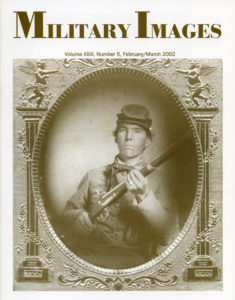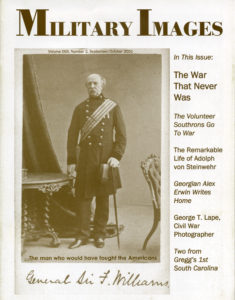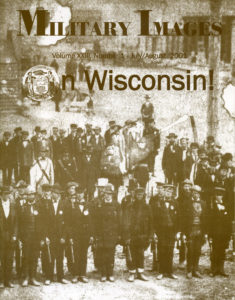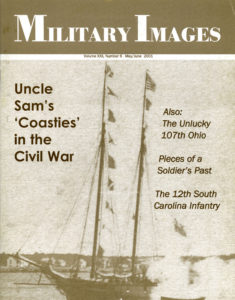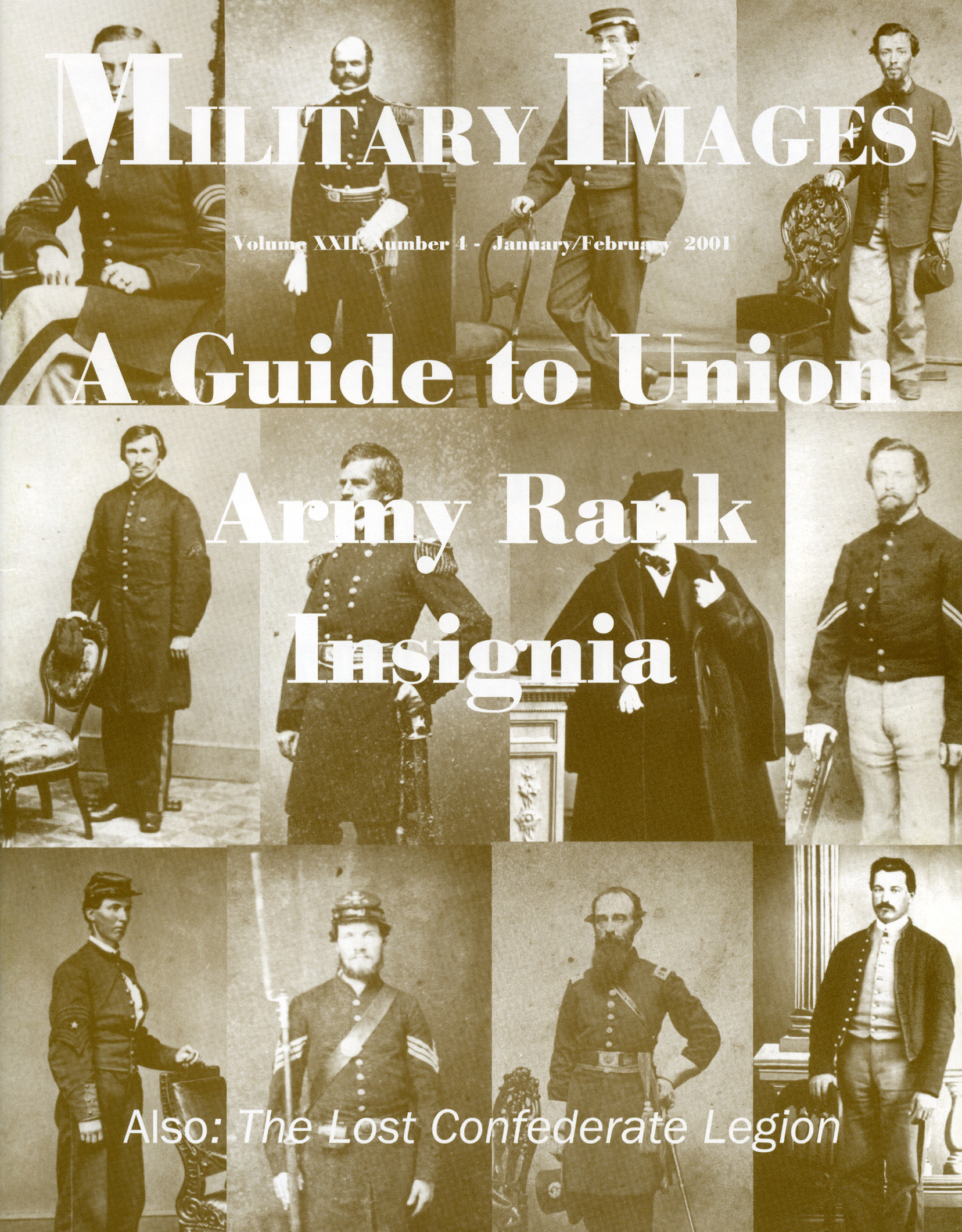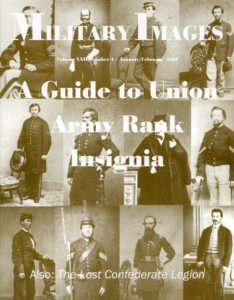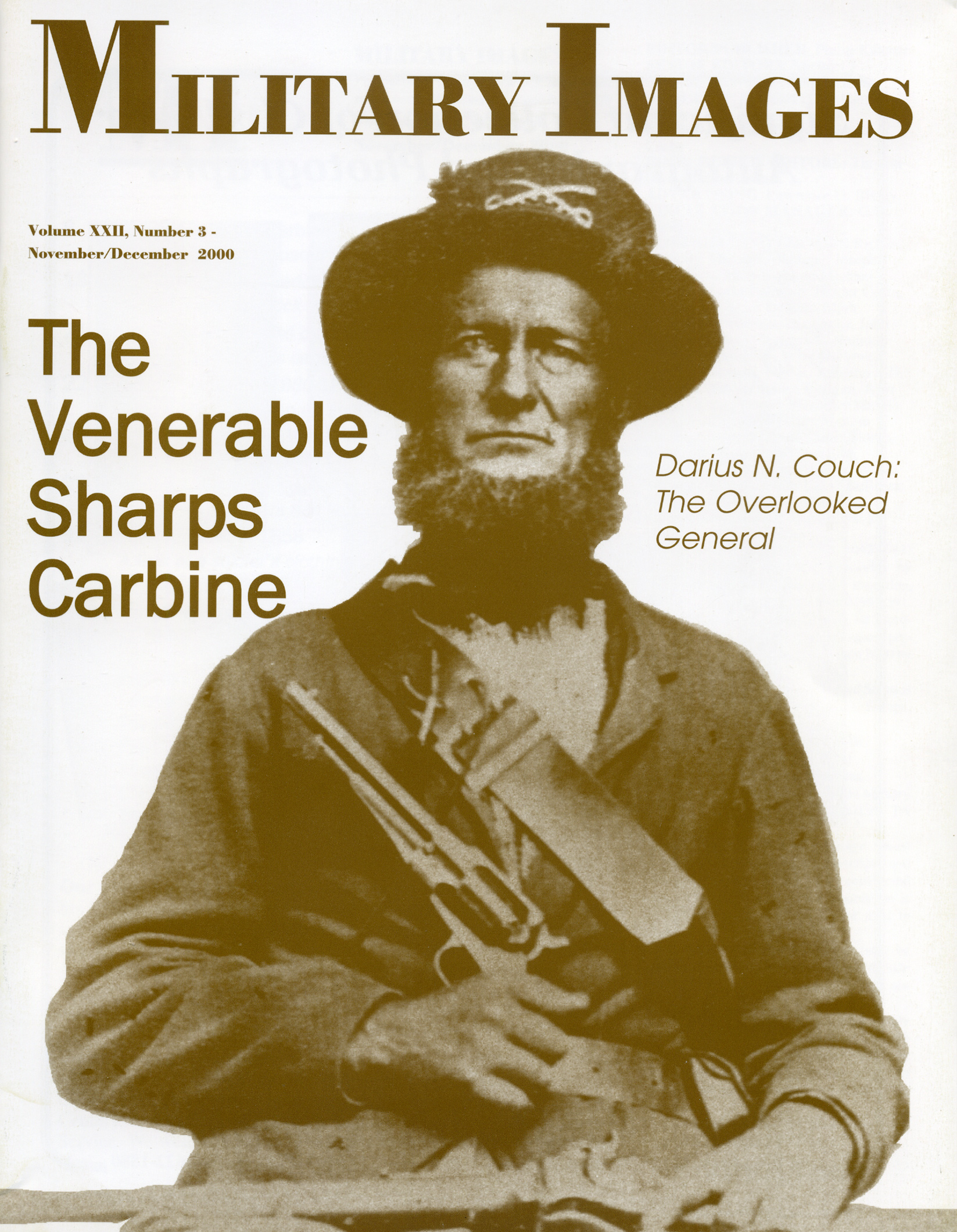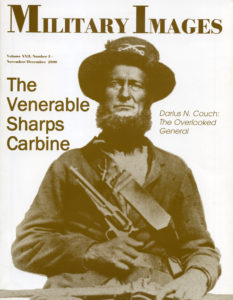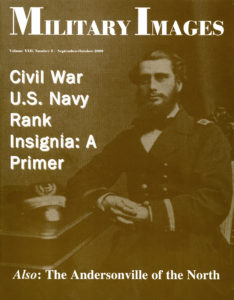The complete issue
Vol. XXIII, No. 5
(40 pages)
Print edition: Visit our store to check availability
Digital edition: Visit JSTOR.org to purchase
Subscribe to MI
Explore the MI Archives: Browse | Advanced search | Tutorial
Inside
Cover image
A hard-plate image from the Roy Mantle collection is a Confederate private holding a converted Model 1816 musket. Note that the date on the cover is February/March 2002 is an error. The months should have been March/April.
Table of Contents (p. 1)
Mail Call (pp. 2-3)
Opinions on the quality of photos reproduced in the magazine continue, and USAMHI Michael J. Winey announces his retirement.
Passing in Review (pp. 4-5)
Three publications are reviewed, including Charleston at War, The Photographic Record 1860-1865 (Thomas Publications) by Jack Thomson, The Civil War and Reconstruction (Oxford University Press) by William L. Barney and Civil War Minutes III (Inecome, Inc.) directed by Mark Bussler.
The Auction Block (p. 6)
A sampling of sales from the popular auction site eBay is included.
Infantry Longarms: A Photo Survey (pp. 7-21)
A catalog of various models and makes is documented with wartime portraits of soldiers posed with the weapons. A grand total of 48 soldier photos are featured and the majority is not identified. Named soldiers all rank as privates and they include Frederick A. Cline of the 40th Missouri Infantry, George Stephens of the 9th New Hampshire Infantry, John M. Fritz of the Veteran Reserve Corps, E.C. Cox of the 11th New York Infantry, Martin Boswer of the 64th Ohio Infantry, Alrott Harden of the 22nd Massachusetts Infantry, Lorenzo Scripture of the 106th New York Infantry, William Richardson of the 2nd Connecticut Heavy Artillery, William Robinson of the 55th Ohio Infantry, George Box of the 147th New York Infantry, Emmanuel Wilderson of the 87th Pennsylvania Infantry and Henry A. Slack of the 169th New York Infantry.
William Tharpe, 46th Tennessee Infantry (p. 22)
An account of Thorpe’s Company E is included here with a mention that he was its commander. His portrait photograph illustrates the text.
The Sword of Daniel Chaplin by Vincent D. Street (pp. 23-24)
The author found the sword that belonged to the officer named in the headline at an estate sale. Chaplin began his war service as colonel of the 2nd Maine Infantry and later served in the 18th Maine Infantry, which was later converted into the 1st Maine Heavy Artillery. An enemy sharpshooter shot and mortally wounded him at Deep Bottom, Va., on Aug. 17, 1864.
Laughing With the Czar by Jerry Harlowe (pp. 25-30)
An 1866 voyage by the monitor Miantonomoh from America to Russia proved that this class of warship could navigate the high seas. The story of the journey is illustrated with images of its crew, including Alexander Murray, James M. Adams, Zera L. Tanner, Frederick C. Imlay, James F. Alcorn, John C. Beaumont, James Pritchett, Francis W. Dickins, That. J. Green, Dr. Walter K. Schofield and James R. Wheeler. Two other images are group portraits of U.S. and Russian naval officers posed together after the Miantonomoh’s safe arrival on the other side of the Atlantic Ocean.
George Jones of the 37th Mass. (p. 31)
The life and times of the Springfield, Mass., resident includes his wounding during the 1864 Battle of Cold Harbor. Jones survived the war. His portrait illustrates the text.
The Hero of Chickamauga by John Sickles (p. 32)
Gilbert Marquis Lafayette Johnson, the subject of this story, served as a captain in the 2nd Indiana Cavalry and as colonel of the 13th Indiana Cavalry. One of his subordinates, William Timberlake, boasted of Johnson’s exploits at the Battle of Chickamauga. The letter is transcribed here. Two wartime portraits of Johnson illustrate the text.
‘If the Original Had Been Thair’ by Mike Fitzpatrick (pp. 33-34)
The story of Sgt. Edward Phillips and his regiment, the 56th Pennsylvania Infantry, includes an accounting of the 1864 battles of Parker’s Store and Weldon Railroad. Phillips suffered wounds in both engagements. He went on to survive the war and live until 1880. A wartime portrait of Phillips illustrates the text.
O.O. Howard Loses an Arm (p. 35)
Oliver Otis Howard, a well-known Union major general, wrote an after-action report of the Battle of Seven Pines in 1862. In it, he mentioned a wound he received that shattered the bone in his right arm and resulted in the amputation of the limb. Howard is pictured here prior to his wound.
Uniforms & History by Michael J. McAfee (pp. 36-37)
In “5th New York, ‘The Red Devils,’” McAfee provides background and uniform details of the famed Zouave regiment. Five images illustrate the text, including portraits of Capt. Churchill J. Cambrelery, Pvt. Samuel H. Tucker and an unidentified private.
Sutler’s Row (pp. 38-39)
The Last Shot (p. 40)
A hard-plate image from the David Hollowell collection is a portrait of Pvt. Eber Divine of the 27th New York Infantry. He holds a Model 1861 rifled musket.


